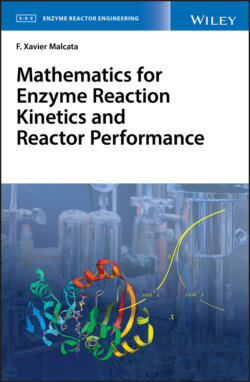Читать книгу Mathematics for Enzyme Reaction Kinetics and Reactor Performance - F. Xavier Malcata - Страница 50
4.5.2 Block Matrix
ОглавлениеOftentimes, matrix A to be inverted appears as a block matrix, in agreement with Eq. (4.86) – so the question is to find its inverse, say, B, in a form consistent with Eq. (4.87); A1,1 and B1,1 will hereafter denote regular (m × m) matrices, A1,2 and B1,2 denote (m × p) matrices, A2,1 and B2,1 denote (p × m) matrices, and A2,2 and B2,2 denote regular (p × p) matrices. Under these conditions, Eq. (4.124) may be reformulated to
(4.166)
so Eq. (4.88) may be retrieved to allow transformation of Eq. (4.166) to
(4.167)
this is equivalent to writing
(4.168)
(4.169)
(4.170)
and
(4.171)
owing to the required equality of matrices in the two sides. Equation (4.169) may be rewritten as
(4.172)
premultiplication of both sides by (which exists because A1,1 is, by hypothesis, a regular square matrix), coupled with Eq. (4.56) and the definition of inverse matrix as per Eq. (4.124) yield
(4.173)
which is equivalent to
(4.174)
at the expense of Eqs. (4.24), (4.57), and (4.64). By the same token, one gets
(4.175)
from Eq. (4.170) – where premultiplication of both sides by produces
(4.176)
at the expense of Eqs. (4.24), (4.57) and (4.124); in view of the definition of identity matrix, one may rewrite Eq. (4.176) as
(4.177)
Insertion of Eq. (4.177) transforms Eq. (4.168) to
(4.178)
where B1,1 may be factored out as
(4.179)
in agreement with Eq. (4.76); isolation of B1,1 then becomes possible via premultiplication of both sides by ( A1,1 − A1,2 A2,1)−1, i.e.
(4.180)
once again with the aid of Eqs. (4.61) and (4.124). One may likewise combine Eqs. (4.171) and (4.174) to get
(4.181)
with the aid of Eq. (4.24), where factoring out of B2,2 yields
(4.182)
again at the expense of Eq. (4.76), besides Eq. (4.8); after premultiplying both sides by ( A2,2 − A2,1 A1,2)−1, while recalling the definition of inverse as per Eq. (4.124) and the major property of an identity matrix as per Eqs. (4.61) and (4.64), one gets
(4.183)
from Eq. (4.182). In view of Eq. (4.183), one may transform Eq. (4.174) as
(4.184)
whereas
(4.185)
results from combination of Eqs. (4.177) and (4.180); therefore, Eqs. (4.180) and (4.183)–(4.185) support reformulation of Eq. (4.87) finally to
(4.186)
since B = A−1 as per Eqs. (4.124) and (4.166). A similar conclusion on the form of A−1 can, as expected from the double equality in Eq. (4.124), be drawn if AB is replaced by BA in Eq. (4.166).
